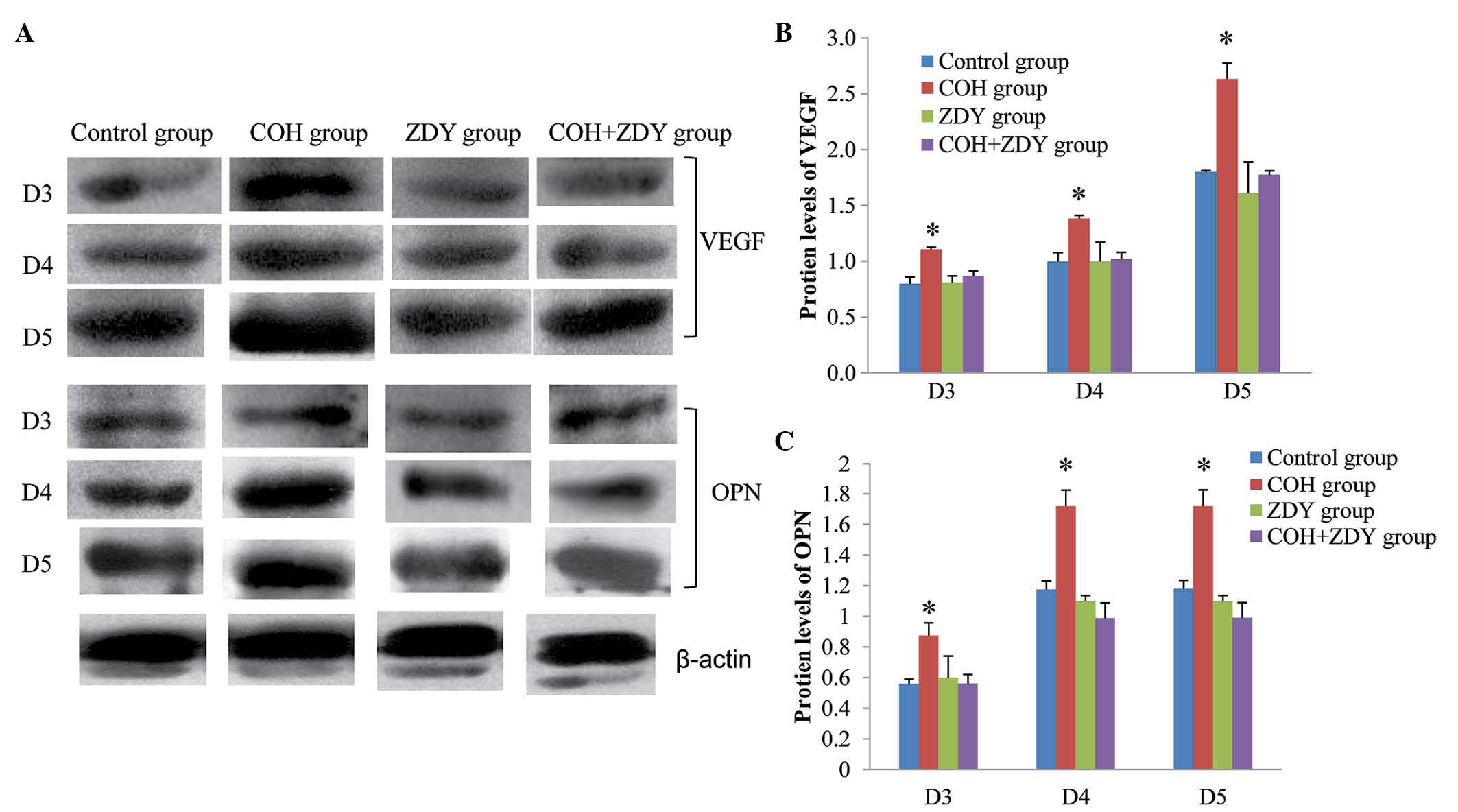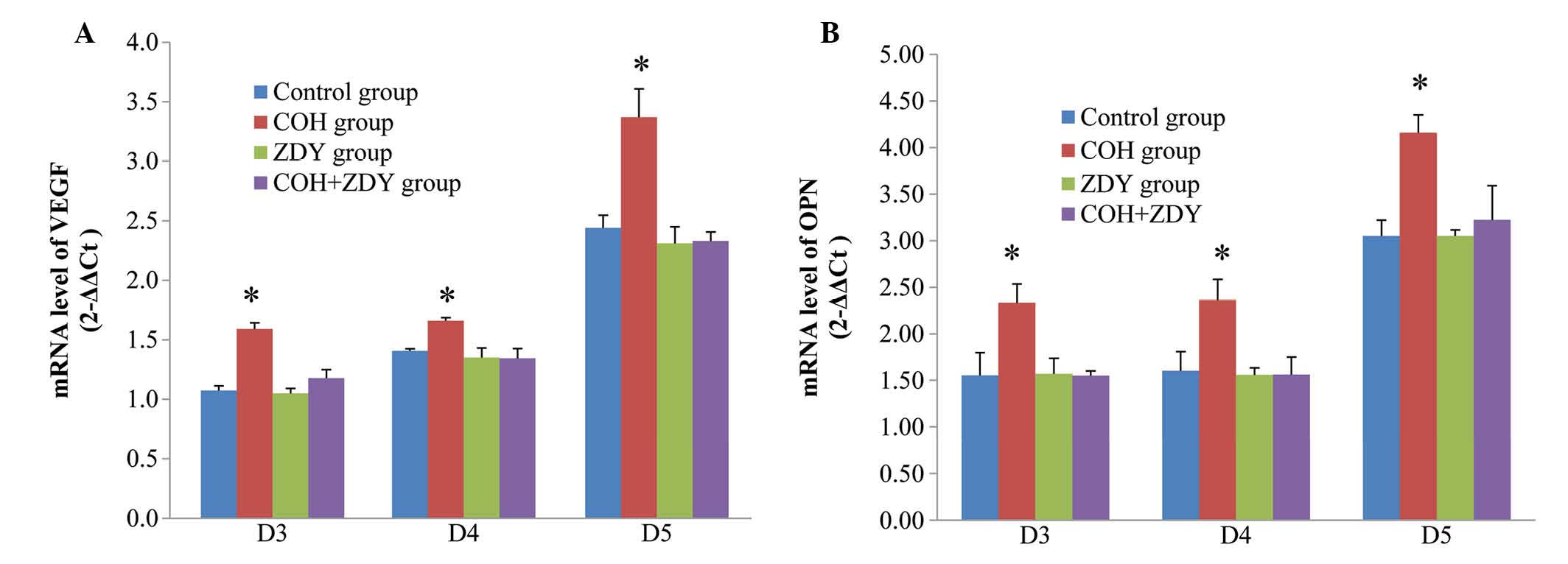|
1
|
Finn CA and Martin L: The control of
implantation. J Reprod Fertil. 39:195–206. 1974. View Article : Google Scholar : PubMed/NCBI
|
|
2
|
Tabibzadeh S and Babaknia A: The signals
and molecular pathways involved in implantation, a symbiotic
interaction between blastocyst and endometrium involving adhesion
and tissue invasion. Hum Reprod. 10:1579–1602. 1995. View Article : Google Scholar : PubMed/NCBI
|
|
3
|
Cakmak H and Taylor HS: Implantation
failure: molecular mechanisms and clinical treatment. Hum Reprod
Update. 17:242–253. 2011. View Article : Google Scholar :
|
|
4
|
Sharkey AM and Smith SK: The endometrium
as a cause of implantation failure. Best Pract Res Clin Obstet
Gynaecol. 17:289–307. 2003. View Article : Google Scholar : PubMed/NCBI
|
|
5
|
Psychoyos A: Hormonal control of
ovoimplantation. Vitam Horm. 31:201–256. 1973. View Article : Google Scholar : PubMed/NCBI
|
|
6
|
Psychoyos A: Hormonal control of uterine
receptivity for nidation. J Reprod Fertil Suppl. 17–28.
1976.PubMed/NCBI
|
|
7
|
Renfree MB and Shaw G: Diapause. Annu Rev
Physiol. 62:353–375. 2000. View Article : Google Scholar : PubMed/NCBI
|
|
8
|
Oldberg A, Franzén A and Heinegård D:
Cloning and sequence analysis of rat bone sialoprotein
(osteopontin) cDNA reveals an Arg-Gly-Asp cell-binding sequence.
Proc Natl Acad Sci USA. 83:8819–8823. 1986. View Article : Google Scholar : PubMed/NCBI
|
|
9
|
Ruoslahti E and Pierschbacher MD: New
perspectives in cell adhesion: RGD and integrins. Science.
238:491–497. 1987. View Article : Google Scholar : PubMed/NCBI
|
|
10
|
Brown LF, Berse B, Van de Water L, et al:
Expression and distribution of osteopontin in human tissues:
widespread association with luminal epithelial surfaces. Mol Biol
Cell. 3:1169–1180. 1992. View Article : Google Scholar : PubMed/NCBI
|
|
11
|
Nomura S, Wills AJ, Edwards DR, Heath JK
and Hogan BL: Developmental expression of 2ar (osteopontin) and
SPARC (osteonectin) RNA as revealed by in situ hybridization. J
Cell Biol. 106:441–450. 1988. View Article : Google Scholar : PubMed/NCBI
|
|
12
|
Maglione D, Guerriero V, Viglietto G, et
al: Two alternative mRNAs coding for the angiogenic factor,
placenta growth factor (PlGF), are transcribed from a single gene
of chromosome 14. Oncogene. 8:925–931. 1993.PubMed/NCBI
|
|
13
|
Rabbani M and Rogers PA: Role of vascular
endothelial growth factor in endometrial vascular events before
implantation in rats. Reproduction. 122:85–90. 2001. View Article : Google Scholar : PubMed/NCBI
|
|
14
|
Rockwell LC, Pillai S, Olson CE and Koos
RD: Inhibition of vascular endothelial growth factor/vascular
permeability factor action blocks estrogen-induced uterine edema
and implantation in rodents. Biol Reprod. 67:1804–1810. 2002.
View Article : Google Scholar : PubMed/NCBI
|
|
15
|
Krüssel JS, Casañ EM, Raga F, et al:
Expression of mRNA for vascular endothelial growth factor
transmembraneous receptors Flt1 and KDR, and the soluble recetor
sflt in cycling human endometrium. Mol Hum Reprod. 5:452–458. 1999.
View Article : Google Scholar
|
|
16
|
de Mouzon J, Goossens V, Bhattacharya S,
et al; European IVF-monitoring (EIM) Consortium, for the European
Society of Human Reproduction and Embryology (ESHRE). Assisted
reproductive technology in Europe, 2006: results generated from
European registers by ESHRE. Hum Reprod. 25:1851–1862. 2010.
View Article : Google Scholar : PubMed/NCBI
|
|
17
|
Levi AJ, Drews MR, Bergh PA, Miller BT and
Scott RT Jr: Controlled ovarian hyperstimulation does not adversely
affect endometrial receptivity in in vitro fertilization cycles.
Fertil Steril. 76:670–674. 2001. View Article : Google Scholar : PubMed/NCBI
|
|
18
|
Pattinson HA, Greene CA, Fleetham J and
Anderson-Sykes SJ: Exogenous control of the cycle simplifies thawed
embryo transfer and results in a pregnancy rate similar to that for
natural cycles. Fertil Steril. 58:627–629. 1992.PubMed/NCBI
|
|
19
|
Pellicer A, Valbuena D, Cano F, Remohí J
and Simón C: Lower implantation rates in high responders: evidence
for an altered endocrine milieu during the preimplantation period.
Fertil Steril. 65:1190–1195. 1996.PubMed/NCBI
|
|
20
|
Bourgain C and Devroey P: The endometrium
in stimulated cycles for IVF. Hum Reprod Update. 9:515–522. 2003.
View Article : Google Scholar
|
|
21
|
Dey SK, Lim H, Das SK, et al: Molecular
cues to implantation. Endocr Rev. 25:341–373. 2004. View Article : Google Scholar : PubMed/NCBI
|
|
22
|
Efferth T, Li PC, Konkimalla VSB and Kaina
B: From traditional Chinese medicine to rational cancer therapy.
Trends Mol Med. 13:353–361. 2007. View Article : Google Scholar : PubMed/NCBI
|
|
23
|
Wen Z, Wang Z, Wang S, et al: Discovery of
molecular mechanisms of traditional Chinese medicinal formula
Si-Wu-Tang using gene expression microarray and connectivity map.
PLoS One. 6:e182782011. View Article : Google Scholar : PubMed/NCBI
|
|
24
|
Wilcox AJ, Weinberg CR, O’Connor JF, et
al: Incidence of early loss of pregnancy. New Engl J Med.
319:189–194. 1988. View Article : Google Scholar : PubMed/NCBI
|
|
25
|
Norwitz ER, Schust DJ and Fisher SJ:
Implantation and the survival of early pregnancy. N Engl J Med.
345:1400–1408. 2001. View Article : Google Scholar
|
|
26
|
Zhong-zhi Q, Yang D, Yan-ze L, et al:
Pharmacopoeia of the People’s Republic of China (2010 Edition): A
Milestone in Development of China’s Healthcare. Chinese Herbal
Medicines. 2:157–160. 2010.
|
|
27
|
Collins PD, Connolly DT and Williams TJ:
Characterization of the increase in vascular permeability induced
by vascular permeability factor in vivo. Br J Pharmacol.
109:195–199. 1993. View Article : Google Scholar : PubMed/NCBI
|
|
28
|
Hippenstiel S, Krüll M, Ikemann A, et al:
VEGF induces hyperpermeability by a direct action on endothelial
cells. Am J Physiol. 274:L678–L684. 1998.PubMed/NCBI
|
|
29
|
Goodger AM and Rogers PA: Uterine
endothelial cell proliferation before and after embryo implantation
in rats. J Reprod Fertil. 99:451–457. 1993. View Article : Google Scholar : PubMed/NCBI
|
|
30
|
Ramsey EM and Donner MW: Placental
Vasculature and Circulation: Anatomy, Physiology, Radiology,
Clinical Aspects: Atlas and Textbook. Thieme; Stuttgart: 1980
|
|
31
|
Jakeman LB, Armanini M, Phillips HS and
Ferrara N: Developmental expression of binding sites and messenger
ribonucleic acid for vascular endothelial growth factor suggests a
role for this protein in vasculogenesis and angiogenesis.
Endocrinology. 133:848–859. 1993.PubMed/NCBI
|
|
32
|
Breier G, Albrecht U, Sterrer S and Risau
W: Expression of vascular endothelial growth factor during
embryonic angiogenesis and endothelial cell differentiation.
Development. 114:521–532. 1992.PubMed/NCBI
|
|
33
|
Giudice LC: Genes associated with
embryonic attachment and implantation and the role of progesterone.
J Reprod Med. 44(2 Suppl): 165–171. 1999.
|
|
34
|
Young MF, Kerr JM, Termine JD, et al: cDNA
cloning, mRNA distribution and heterogeneity, chromosomal location,
and RFLP analysis of human osteopontin (OPN). Genomics. 7:491–502.
1990. View Article : Google Scholar : PubMed/NCBI
|
|
35
|
Carson DD, Lagow E, Thathiah A, et al:
Changes in gene expression during the early to mid-luteal
(receptive phase) transition in human endometrium detected by
high-density microarray screening. Mol Hum Reprod. 8:871–879. 2002.
View Article : Google Scholar : PubMed/NCBI
|
|
36
|
Kao L, Tulac S, Lobo SA, et al: Global
gene profiling in human endometrium during the window of
implantation. Endocrinology. 143:2119–2138. 2002. View Article : Google Scholar : PubMed/NCBI
|
|
37
|
Borthwick JM, Charnock-Jones DS, Tom BD,
et al: Determination of the transcript profile of human
endometrium. Mol Hum Reprod. 9:19–33. 2003. View Article : Google Scholar : PubMed/NCBI
|
|
38
|
Talbi S, Hamilton A, Vo K, et al:
Molecular phenotyping of human endometrium distinguishes menstrual
cycle phases and underlying biological processes in normo-ovulatory
women. Endocrinology. 147:1097–1121. 2006. View Article : Google Scholar
|
|
39
|
Chaen T, Konno T, Egashira M, et al:
Estrogen-dependent uterine secretion of osteopontin activates
blastocyst adhesion competence. PLoS One. 7:e489332012. View Article : Google Scholar : PubMed/NCBI
|
|
40
|
Liaw L, Birk DE, Ballas CB, Whitsitt JS,
Davidson JM and Hogan BL: Altered wound healing in mice lacking a
functional osteopontin gene (spp1). J Clin Invest. 101:1468–1478.
1998. View
Article : Google Scholar : PubMed/NCBI
|
|
41
|
Rittling SR, Matsumoto HN, Mckee MD, et
al: Mice lacking osteopontin show normal development and bone
structure but display altered osteoclast formation in vitro. J Bone
Miner Res. 13:1101–1111. 1998. View Article : Google Scholar : PubMed/NCBI
|
|
42
|
Liaw L, Almeida M, Hart CE, Schwartz SM
and Giachelli CM: Osteopontin promotes vascular cell adhesion and
spreading and is chemotactic for smooth muscle cells in vitro. Circ
Res. 74:214–224. 1994. View Article : Google Scholar : PubMed/NCBI
|
|
43
|
Beaumont HM and Smith AF: Embryonic
mortality during the pre- and post-implantation periods of
pregnancy in mature mice after superovulation. J Reprod Fertil.
45:437–448. 1975. View Article : Google Scholar : PubMed/NCBI
|
|
44
|
Ertzeid G and Storeng R: Adverse effects
of gonadotrophin treatment on pre- and postimplantation development
in mice. J Reprod Fertil. 96:649–655. 1992. View Article : Google Scholar : PubMed/NCBI
|
|
45
|
McKiernan SH and Bavister BD:
Gonadotrophin stimulation of donor females decreases
post-implantation viability of cultured one-cell hamster embryos.
Hum Reprod. 13:724–729. 1998. View Article : Google Scholar : PubMed/NCBI
|
|
46
|
Miller BG and Armstrong DT: Effects of a
superovulatory dose of pregnant mare serum gonadotropin on ovarian
function, serum estradiol, and progesterone levels and early embryo
development in immature rats. Biol Reprod. 25:261–271. 1981.
View Article : Google Scholar : PubMed/NCBI
|
|
47
|
Ertzeid G and Storeng R: The impact of
ovarian stimulation on implantation and fetal development in mice.
Hum Reprod. 16:221–225. 2001. View Article : Google Scholar : PubMed/NCBI
|
|
48
|
Foote R and Ellington J: Is a
superovulated oocyte normal? Theriogenology. 29:111–123. 1988.
View Article : Google Scholar
|
|
49
|
Allen J and McLaren A: Cleavage rate of
mouse eggs from induced and spontaneous ovulation. J Reprod Fertil.
27:137–140. 1971. View Article : Google Scholar : PubMed/NCBI
|
|
50
|
Makrigiannakis A, Minas V, Kalantaridou
SN, Nikas G and Chrousos GP: Hormonal and cytokine regulation of
early implantation. Trends Endocrinol Metab. 17:178–185. 2006.
View Article : Google Scholar : PubMed/NCBI
|
|
51
|
Ruan HC, Zhu XM, Luo Q, et al: Ovarian
stimulation with GnRH agonist, but not GnRH antagonist, partially
restores the expression of endometrial integrin beta3 and
leukaemia-inhibitory factor and improves uterine receptivity in
mice. Hum Reprod. 21:2521–2529. 2006. View Article : Google Scholar : PubMed/NCBI
|
















